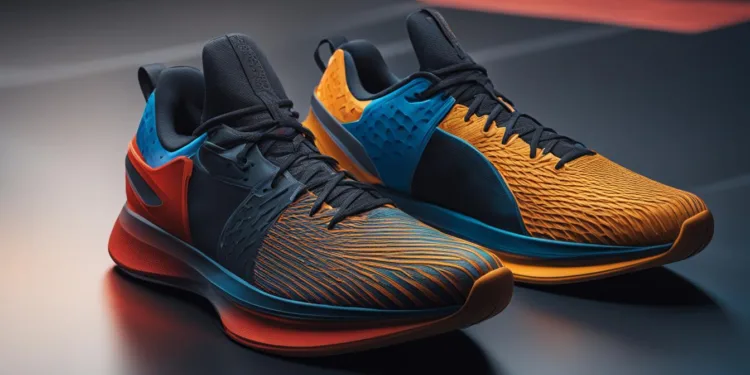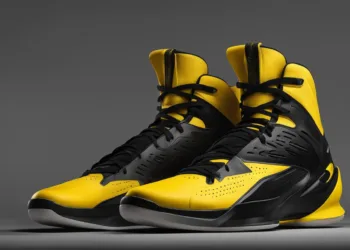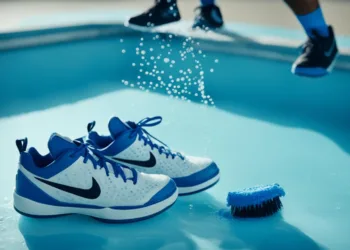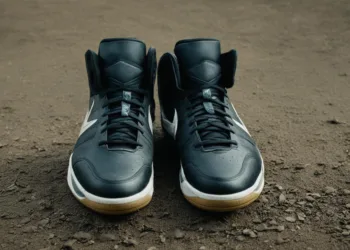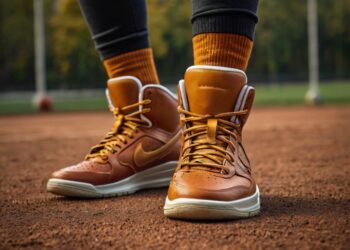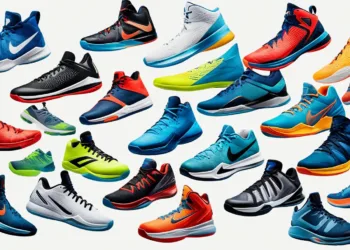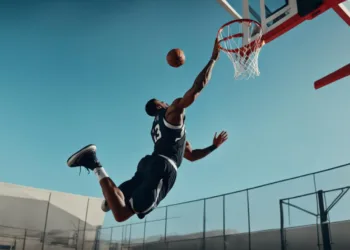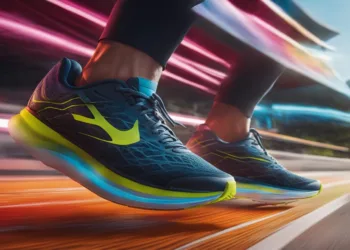Table of Contents
- 1 Athletic Footwear Anatomy: Exploring the Build for Court and Track
- 2 The Significance of Sole Design in Selecting Sports Shoes
- 3 Understanding the Athletic Demands: Basketball vs Running Shoes
- 4 Pros and Cons of Interchanging Court and Track Shoes
- 5 Basketball vs Running Shoes: Weighing Your Choices
- 6 Expert Recommendations on Choosing Athletic Shoes
- 7 Steps Forward: Merging Athletic Footwear Advances for Versatility
When you’re at the crossroads of selecting the ideal footwear for your athletic pursuits, understanding the key differences in basketball vs running shoes can be your roadmap to enhanced performance and comfort. The intricate dance between athletic footwear comparison and sports discipline specificity frames the essence of sports shoe selection.
Would you wear the same sneakers for scoring three-pointers as you would for a marathon? Not quite. The performance footwear comparison is not just about style; it’s a question of function. Basketball shoes are crafted to manage jumps and sharp cuts, providing your ankles with the fortress they need. Running shoes, however, cater to the persistent impact of your feet hitting the pavement, aimed at keeping the spring in your step over the long haul.
Whether you’re dodging defenders on the court or pacing through the last mile on the track, making a well-informed decision in your sports shoe selection is pivotal. In this guide, we lace up and dive into the nuances that separate the court kings from the track titans, ensuring you make the slam dunk decision for your feet. Let’s step into the world of basketball vs running shoes, dissect their unique attributes, and navigate the maze of athletic footwear comparison to bolster your game or race day readiness. Discover our top picks for 2024.
Key Takeaways:
- Understanding athletic footwear anatomy
- Importance of sole design in sports shoes
- Comparing the athletic demands of basketball and running shoes
- Pros and cons of interchanging sports shoes
- Weighing choices between basketball and running shoes
- Expert advice on choosing athletic shoes
- Future of athletic footwear: Merging advances for versatility
Athletic Footwear Anatomy: Exploring the Build for Court and Track
When choosing athletic shoes, understanding the anatomy of your footwear can significantly influence your performance, whether you’re gliding on a court or racing along a track. The design innovations in shoes tailored for basketball and running highlight the stark basketball and running shoe differences and underscore the importance of choosing the right shoe for the right activity.
Materials in Basketball Shoes vs Running Shoes
The materials used in sports shoes play a pivotal role in their functionality and suitability for specific activities. Basketball shoes often employ robust materials like leather to withstand the aggressive movement patterns seen on the court, whereas running shoes commonly incorporate a lightweight mesh to maximize breathability and ease the continuous motion associated with running.
Importance of Flexibility and Stability in Performance Footwear
The tug-of-war between flexibility and stability is at the heart of performance footwear. The flexible soles of running shoes accommodate the linear, repetitive impact during long-distance jogs or sprints, aiding in forward propulsion. In contrast, basketball shoes have to balance flexibility with stability to manage sharp cuts and stops, a necessity for on-court agility and player safety.
Ankle Support Features for Lateral Movement on the Court
One cannot discuss court vs track shoes without examining the ankle support features. Basketball shoes are equipped with structures, such as higher ankle collars or robust lacing systems, that provide essential support for the lateral movements and sudden direction changes characteristic of the game—carefully engineered features to prevent ankle injuries during the heat of competition.
| Feature | Basketball Shoes | Running Shoes |
|---|---|---|
| Material | Durable (e.g., leather, synthetics) | Lightweight (e.g., mesh, knit) |
| Flexibility | Structured for lateral support | Highly flexible for forward movement |
| Ankle Support | High tops for added stability | Low cut for unrestricted movement |
| Design Purpose | Lateral moves, sprints, jumps | Long-distance, linear impact absorption |
Knowledge of these differences is crucial for athletes and casual enthusiasts alike, ensuring that when the time comes to make a selection, you’re equipped with the information needed for an informed and strategic athletic footwear comparison.
“read more: Flexible Low-Top Basketball Shoes“
The Significance of Sole Design in Selecting Sports Shoes
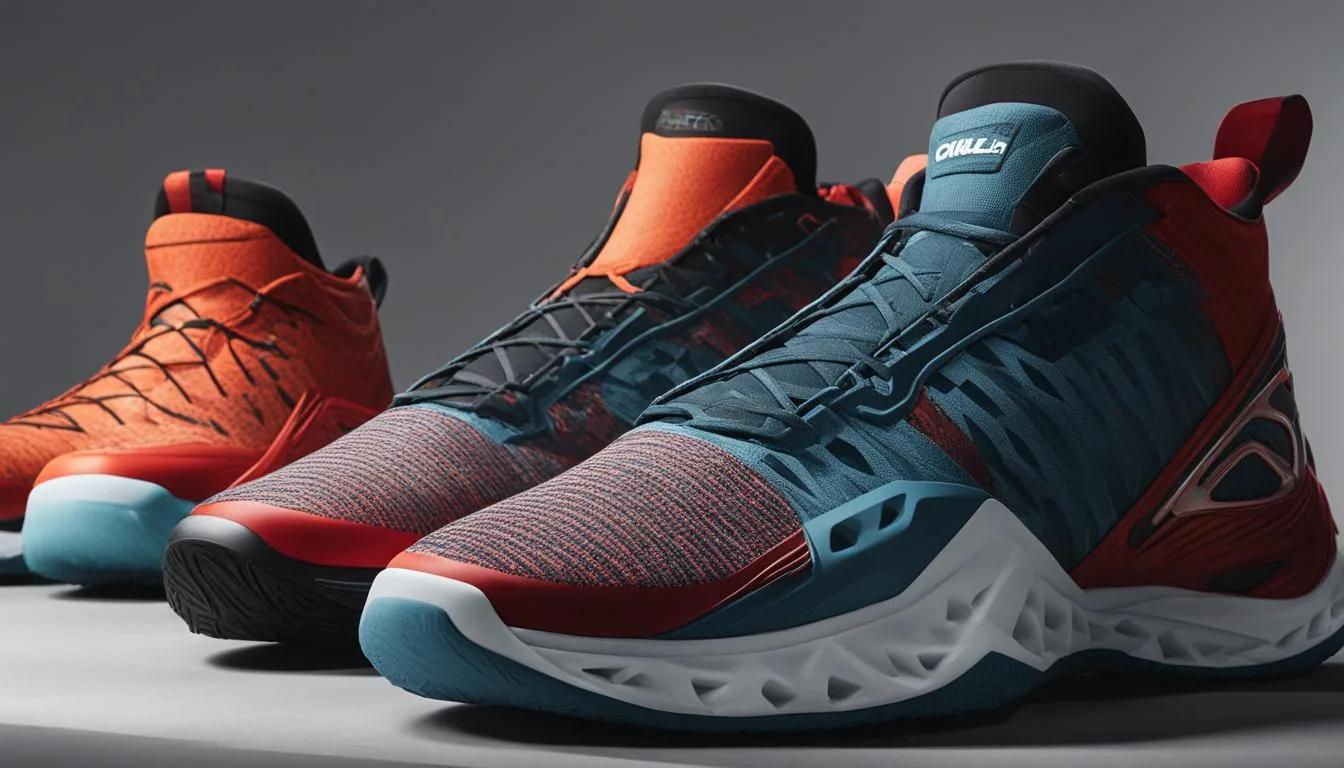
When it comes to choosing sports sneakers for specific activities, the sole of the shoe is a crucial factor that directly impacts performance. In a performance footwear comparison, we find significant distinctions between the soles of basketball shoes and running shoes. While basketball soles are crafted to facilitate lateral movement and quick pivots, running shoe soles cater to forward motion, demanding lasting durability and cushioning on diverse terrains.
Basketball soles, traditionally optimized for indoor court play, offer excellent grip that supports abrupt starts and stops. Their composition, however, is not intended for abrasive surfaces outside the polished floors of a basketball court. Consequently, using them for continuous running activities on less forgiving ground can expedite the wearing process, resulting in diminished efficacy and lifespan.
In contrast, running shoe soles are engineered to absorb the repeated pounding of feet on the ground, particularly over long distances. Manufacturers of running shoes integrate advanced materials that not only cushion every stride but also provide terrain-specific traction, whether on pavements or trails. These soles are built to last, regardless of the running surface, demonstrating their versatility across various outdoor environments.
- Traction: Basketball shoes feature sole patterns designed for the smooth court surface, offering high grip capacities necessary for the game. Running shoes, however, present multi-surface traction suitable for pavement, tracks, or natural trails, tackling a broader range of environments.
- Cushioning: The cushioning within running shoe soles is pronounced to ensure energy absorption and comfort with every step, while basketball shoes have a firmer, less pronounced cushioning to accommodate the dynamic play of basketball.
- Durability: Sole durability in running shoes is geared towards withstanding the elements and rougher terrains—contrasted with basketball soles made for the relatively controlled conditions of a basketball court.
Your selection of sports sneakers for specific activities should align with these differences in sole design. Recognizing these unique characteristics is pivotal in guiding your decision-making process for performance footwear comparison and purchase. Match your shoe to your sport to maximize both your comfort and athletic potential.
“read also: Speed Oriented Low-Tops Basketball Shoes“
Understanding the Athletic Demands: Basketball vs Running Shoes
When you step onto the court or hit the pavement, the demands of each sport call for specialized footwear. In the world of athletic footwear comparison, particularly basketball vs running shoes, your choice can be the difference between peak performance and sidelined injury.
How Quick Stops and Sprints Influence Shoe Design
Basketball players know the importance of quick stops and explosive sprints, movements that necessitate a shoe designed with these actions in mind. The creativity and rapid directional changes of basketball call for shoes with superior ankle support, heightened traction, and the perfect blend of flexibility and stability – a balance that allows athletes to push their limits without compromising on safety or control.
The Role of Cushioning for Impact Absorption During Activities
As you run or jump, your feet absorb the shock of contact; this is where cushioning plays a vital role. For runners, shoes with adequate cushioning are fundamental, absorbing the repetitive impact with each stride. Basketball players, however, rely on cushioning to mitigate the shock from frequent jumps and hard landings, protecting their joints and muscles during high-intensity play.
Comparing Durability and Performance on Various Surfaces
The clash between basketball and running shoes isn’t just about function; it’s also about longevity. Running shoes are constructed to tackle a mix of surfaces, from the unforgiving hardness of asphalt to the unpredictable nature of trails. Basketball shoes are constructed for the indoor court environment, prioritizing grip and durability on sleek surfaces, but they may falter on the contrasting terrains runners face.
Remember, when it comes to sports shoe selection, the devil is in the details. Each sport imposes unique demands on your footwear; thus, determining which shoe is right for you depends on the athletic challenges you plan to take on. Make your athletic footwear comparison based on the specific attributes that align with your active lifestyle, whether that’s maneuvering on the maple hardwood or pacing through a marathon.
“read more: Minimalist Low-Top Basketball Shoes“
Pros and Cons of Interchanging Court and Track Shoes
Interchanging athletic footwear like basketball vs running shoes can be tempting for the sake of convenience or to save on costs. However, when it comes to choosing athletic shoes, one needs to be aware of the specific design intentions and characteristics that affect performance and safety. Below, examine the pros and cons to understand why an athletic footwear comparison is essential before you cross lines from court to track or vice versa.
- Comfort on Short Runs: Basketball shoes can be comfortable for short jogs or sprints; their cushioning and fit may suit incidental runs off the court.
- Ankle Support: The high-top design of basketball shoes offers robust ankle support, which can be perceived as an advantage when making occasional runs.
Despite these benefits, the cons can be far more impactful on your athletic experience:
- Weight: Basketball shoes are generally heavier, which can lead to quicker onset of fatigue when used for running.
- Shock Absorption: Engineered for the court, basketball shoes lack adequate shock absorption for the repetitive impact of running, possibly leading to foot discomfort or conditions like plantar fasciitis.
- Long-Term Foot Health: Running regularly in basketball shoes may not show immediate detrimental effects, but over time, the lack of proper running support can lead to health concerns.
- Traction and Stability: While sufficient for court use, basketball shoes’ traction patterns may not offer the stability needed for the variety of surfaces encountered when running outdoors.
- Risk of Ankle Injury: Conversely, running shoes typically have lower ankle support, which could increase the risk of ankle injuries during the lateral movements and quick direction changes in basketball.
Below is a table highlighting the primary differences in construction that affect the interchangeability of these shoes.
| Aspect | Basketball Shoes | Running Shoes |
|---|---|---|
| Ankle Support | High collars for stable ankle support | Low-cut design for flexible ankle movement |
| Weight | Heavier for court stability | Lighter for running endurance |
| Shock Absorption | Engineered for jumps and quick stops | Maximized for repetitive, continuous impact |
| Traction | Optimized for indoor courts | Adapted for varied outdoor terrains |
| Long-Term Use | Not ideal for long-distance running | Constructed for extensive mileage |
When making your decision, consider how these factors align with your athletic routines. To prevent unnecessary strain or potential injury, invest in proper footwear that is designed for your primary activity. Ultimately, the right shoe is a vital tool in achieving your best performance while caring for your body’s long-term athletic health.
“read also: Classic Style High-Top Basketball Shoes“
Basketball vs Running Shoes: Weighing Your Choices
When it’s time to upgrade your athletic wear, the dilemma between basketball vs running shoes can be a real challenge. To make an educated sports shoe selection, you need to address your specific needs and the demands of your favorite activities. Let’s navigate the path towards finding the optimal sports sneakers for specific activities.
Are you engaging in agile maneuvers and quick pivots on the court, or are you pacing yourself for endurance over miles of track or pavement? The answer to this question holds the key to selecting the perfect pair of sneakers. For those of you who pivot on the hardwood, basketball shoes offer stellar support and protection, specifically designed for the intensity of the game. On the other hand, if you’re hitting the pavements, running shoes provide the lightweight construction and cushioning necessary for those long-distance strides.
Diving deeper, let’s look at their features more closely:
- Protection: Basketball shoes are engineered with increased protection to guard against the sudden stops and quick direction changes common in the sport.
- Support: Offering a sturdier build, they protect and support the ankle during dynamic movements.
- Lightweight Construction: Running shoes shed extra weight to enhance your running efficiency over long distances.
- Cushioning: Designed with enhanced cushioning, they absorb the impact of your run, preventing joint stress.
To ensure you’re making the best choice, let’s compare some essential characteristics:
| Feature | Advantage in Basketball Shoes | Advantage in Running Shoes |
|---|---|---|
| Weight | Heavier to offer stability | Lighter for endurance and speed |
| Cushioning | Localized to pivot points | Uniform for stride absorption |
| Traction | Designed for polished surfaces | Varied for multiple terrains |
| Build | Sturdy for lateral support | Flexible for forward motion |
At the end of the day, your shoe should resonate with your athletic pursuit. Whether that be a game of hoops or a track race, the ideal sports sneakers for specific activities might indeed be different but are crucial to your performance and safety. Keep these considerations in mind, and you’ll be lacing up the perfect pair in no time.
“read also: Reinforced Low-Top Basketball Shoes“
Expert Recommendations on Choosing Athletic Shoes
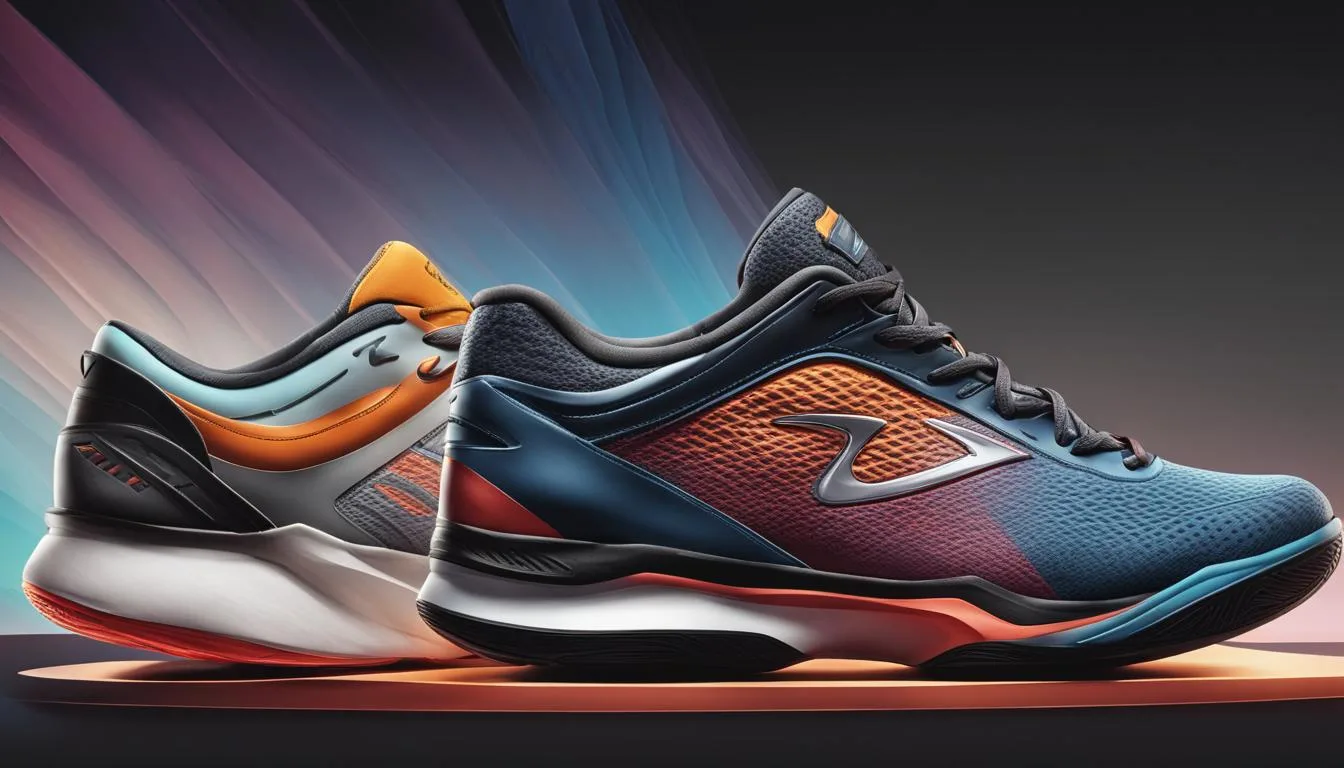
Stepping into the right pair of athletic shoes can make all the difference in your sports performance and comfort. Whether you’re a basketball player looking for shoes to support lateral moves, or a runner in need of sneakers that can handle the miles, the key is in the details of the design. This section explores the tailored features you should seek out to ensure that your footwear maximizes your efforts on the court and on the track.
What to Look for in Basketball Shoes for Runners
If you’re a runner who occasionally enjoys basketball, selecting the right shoe requires a balance. A thinner outsole provides a better feel of the ground, which is crucial for quick, short-distance runs, without sacrificing the grip needed on the court. A lighter design aids in reducing the weight you’re carrying, making those spurts up and down the court less taxing on your legs.
Key Considerations for Running Shoe Selection by Basketball Players
Conversely, basketball players dabbling in running should eye running shoes that offer stability without forfeiting flexibility. This means seeking out a shoe with enough traction to help with directional changes—an aspect as vital on the track as it is on the court. Runners demand shoes that provide a stable base yet are flexible enough to accommodate their natural stride.
Top Picks: A Compilation of Best Sports Sneakers for Specific Activities
Navigating through the myriad choices of sports sneakers can be daunting. However, blending the expert advice with real-world user experience can lead to some top recommendations for those seeking to straddle the line between basketball agility and running endurance. Below, find a table compiling the best sports sneakers that have been vetted for specific activities and defined by their standout features.
| Shoe Model | Type | Key Feature | Best Use |
|---|---|---|---|
| Nike Air Zoom BB NXT | Basketball | Responsive cushioning | High-impact court play |
| Adidas Ultraboost 21 | Running | Primeblue high-performance recycled material | Long-distance runs |
| Under Armour Curry 8 | Basketball/Running Hybrid | Flexibility and support | Versatile court-to-track transitions |
| Asics Gel-Kayano 27 | Running | DuoMax Support System | Stability for overpronators |
| Reebok Nano X1 | Cross-Training | Comfortable and versatile | General athletic use |
As you weigh your options, look for sneakers that provide a synergy of overall comfort, ample support, reliable traction, and a level of cushioning that’s appropriate for your activity. Whether you’re sprinting down the court or hitting the pavement, the intricate balance between these elements defines the performance footwear comparison and the satisfaction you will derive from your chosen pair of athletic shoes.
Steps Forward: Merging Athletic Footwear Advances for Versatility
As you navigate the evolving landscape of athletic footwear, innovations are breaching the once-distinct divides of sport-specific shoes. The imminent horizon of athletic footwear comparison sees basketball and running shoes not as rivals, but as mutual participants in a coherent design approach. This synergy aims to equip you, the athlete who dashes across variegated domains, with a sports shoe selection that transcends traditional limitations, offering seamless versatility without compromising on performance. The court vs track shoes debate is thus transcended, fostering a new breed of hybrids that cater to the agility required on the hardwood as well as the endurance demanded on the track.
In your search for the perfect shoe, consider the merits of embracing advancements that reflect a blend of basketball vs running shoes. Imagining a future where shoes are not confined to a single sport but can adeptly handle the leap from a pick-up game to a spontaneous run, bestows upon your feet the freedom to excel in a broader range of activities. It’s a move towards a more integrative and intelligent sports shoe selection, melding the best qualities of cushioning and stability, lightweight builds and responsive traction—all crafted to meet the athletic calls of varied terrains and unpredictable plays.
With research and development fervently pursuing this paradigm, the athletic footwear comparison of tomorrow suggests that your performance does not have to be bound by the shoes you choose to wear for one sport over another. Leveraging the fusion of these advancements affords you the liberty to pivot between disciplines, ensuring that your athletic prowess is only amplified by the versatility at your feet. As the realms of court and track intertwine, your footwear becomes an extension of this athletic duality, propelling you towards a future where variety is not just the spice of life, but the hallmark of your athletic endeavors.
- best basketball shoes for big men
- best basketball shoes under 50
- Basketball Shoes Near Me
- Basketball Shoes Nike
In conclusion, the choice between basketball and running shoes depends on the specific demands of the sport and personal comfort. While basketball shoes are designed to support quick, multidirectional movements and provide a good grip on the court, running shoes are built for forward motion and cushioning impact. Interchanging these shoes may not provide optimal performance.
Therefore, it’s essential to consider the design, build, and purpose of the shoes when making a selection. Whether you’re an NBA player, a point guard, or a trail runner, wearing the right footwear can significantly enhance your performance and prevent unnecessary strain on your feet. Remember, the best shoe is the one that fits well, feels comfortable, and suits your athletic needs. So, weigh your choices and make an informed decision. Happy sporting!
When it comes to choosing between basketball and running shoes, it’s important to consider the specific demands of your activity. Basketball footwear tends to be heavier than running shoes, created to support fast, multidirectional trends and provide a good grip on the court. On the other hand, running shoes are built for forward movement and cushioning impact, making them ideal for trail running or road running.
Remember, wearing running shoes for basketball or vice versa may not provide optimal implementation and could potentially lead to injuries. Therefore, it’s generally recommended to have a separate pair of running shoes and basketball shoes.
Also, consider the fact that basketball involves a lot of jumping, so you’ll want shoes that can help you land from a rebound safely. On the other hand, if you’re into trail running, you’ll need shoes that can handle the rough terrain.
the best running shoes or basketball shoes are the ones that fit well, feel comfortable, and suit your athletic needs. So, weigh your options and make an informed decision. Happy sporting!


